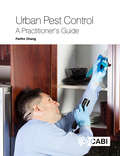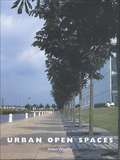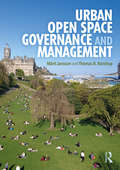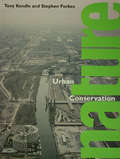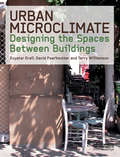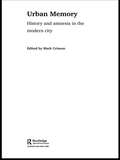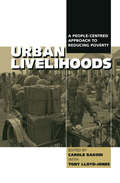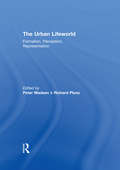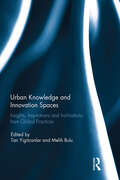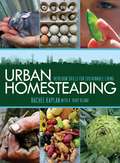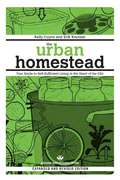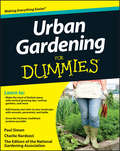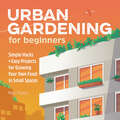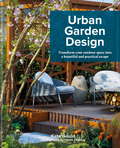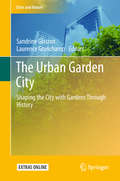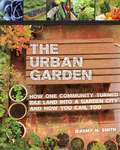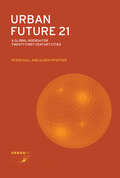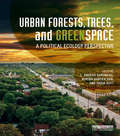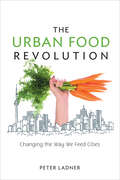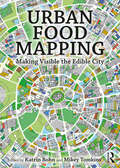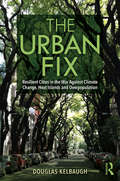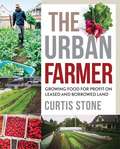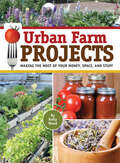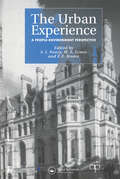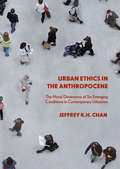- Table View
- List View
Urban Pest Control: A Practitioner Guide
by Partho DhangThis guide brings together the varied and multiple skills and activities required of pest control practitioners, including biology, chemistry, architecture, engineering, sales, logistics, legal and accounting, presented with a primary emphasis on pest organisms at its core. This book provides information and tips on all of these aspects and explores the business of controlling pests (including trends in the industry, pest control tools, and sustainable pest control); covers biological information on each pest in addition to information on control and management, monitoring and follow-up; focuses particularly on globally significant pests with internationally-applicable use and guidance; and provides practical and hands-on experience, drawing on original case studies. This is a key resource for pest control practitioners, as well as in-house staff of companies or buildings involved in household or urban pest control. It is also a valuable reference for researchers, and sanitation and building managers.
Urban Open Spaces
by Helen WoolleyThere is enormous interest in urban design and the regeneration of our urban areas, but current thinking often concentrates on the built form, forgetting the important role that open spaces play. Urban Open Spaces brings together extensive research and practical experience to prove the opportunities and benefits of different types of open space to society and individuals. Focusing on the importance of open spaces in daily urban life, the book is divided into three sections. The first section describes the social, health, environmental and economic benefits and opportunities that open spaces can provide. The second section discusses the different types of urban open spaces that individuals or communities might use on a daily basis: from private gardens to commercial squares and waterway corridors. The final section provides best practice case-studies demonstrating urban spaces being incorporated in new developments and community initiatives. This is the first book to bring together a variety of evidence from different disciplines to outline the benefits and opportunities of urban open spaces in an accessible way. Not just for students and practitioners, this book will be of value for anyone interested in the design, development, regeneration, funding and use of open spaces in urban areas.
Urban Open Space Governance and Management
by Märit Jansson Thomas B. RandrupThis edited volume defines and compares central aspects of governance and management related to urban open spaces (UOSs) such as long-term management, combined governance and management and strategic management of UOSs. Perspectives such as ethical considerations, user participation and changes in local governmental structures frame the governance and management of UOSs. Jansson and Randrup create a comprehensive resource detailing global trends from framing and understanding to finally practising UOS governance and management. They conclude by promoting positive changes, such as proactive management and strategic maintenance plans to encourage the creation of more sustainable cities. Illustrated in full colour throughout, this book is an essential read for students and academics of landscape architecture, planning and urban design, as well as those with a particular interest in governance and management of UOSs.
Urban Nature Conservation: Landscape Management in the Urban Countryside
by Stephen Forbes Tony KendleUrban nature conservation is a field that has grown rapidly in importance over the past 20 years and will continue to do so in the coming years as landscape ecology and greenspace planning become established disciplines. A widespread concern and interest in the wild plants and animal life found in urban areas now influences the policies and practices of land management organizations. This book provides a comprehensive overview of the subject. It will assist professionals in formulating strategic management policies that integrate urban nature conservation into the wider context of landscape management and urban planning.
Urban Microclimate: Designing the Spaces Between Buildings
by Evyatar Erell David Pearlmutter Terence WilliamsonThe quality of life of millions of people living in cities could be improved if the form of the city were to evolve in a manner appropriate to its climatic context. Climatically responsive urban design is vital to any notion of sustainability: it enables individual buildings to make use of renewable energy sources for passive heating and cooling, it enhances pedestrian comfort and activity in outdoor spaces, and it may even encourage city dwellers to moderate their dependence on private vehicles. Urban Microclimate bridges the gap between climatology research and applied urban design. It provides architects and urban design professionals with an understanding of how the structure of the built environment at all scales affects microclimatic conditions in the space between buildings, and analyzes the interaction between microclimate and each of the elements of the urban landscape. In the first two sections of the book, the extensive body of work on this subject by climatologists and geographers is presented in the language of architecture and planning professionals. The third section follows each step in the design process, and in part four a critical analysis of selected case study projects provides a demonstration of the complexity of applied urban design. Practitioners will find in this book a useful guide to consult, as they address these key environmental issues in their own work.
Urban Memory: History and Amnesia in the Modern City
by Mark CrinsonNine previously unpublished essays form an interdisciplinary assessment of urban memory in the modern city, analysing this burgeoning area of interest from the perspectives of sociology, architectural and art history, psychoanalysis, culture and critical theory. Featuring a wealth of illustrations, images, maps and specially commissioned artwork, this work applies a critical and creative approach to existing theories of urban memory, and examines how these ideas are actualised in the forms of the built environment in the modernist and post-industrial city. A particular area of focus is post-industrial Manchester, but the book also includes studies of current-day Singapore, New York after 9/11, modern museums in industrial gallery spaces, the writings of Paul Auster and W.G. Sebald, memorials built in concrete, and contemporary art.
Urban Livelihoods: A People-centred Approach to Reducing Poverty
by Tony Lloyd-Jones Carole RakodiOne of the most promising approaches to poverty reduction in developing countries is to encourage sustainable livelihoods for the poor. This takes account of their opportunities and assets and the sources of their vulnerability. Based on recent and extensive research, this volume thoroughly assesses the value of the livelihoods approach to urban poverty. The book reviews the situation and strategies of the urban poor and identifies the policies and practical programmes that work best. Lasting improvements depend not just on economic development, but on political commitment and structures that are responsive to the claims and needs of different groups of poor people.
The Urban Lifeworld: Formation Perception Representation
by Peter Madsen Richard PlunzUrban conditions are crucial to our experience of modernity, and, as reflected by art, literature and popular culture, have influenced contemporary ideas of what urban life is about.The Urban Lifeworld contributes to our understanding of the cultural role of cities by offering new insight into the analysis of urban experience. Two exceptional cities, New York and Copenhagen, are the focus of this exploration of cultural representations of urban life, which investigates the contrasts between perceptions and formation of the urban lifeworld.Integrating sociological, aesthetic and anthropological approaches to urban questions, this collection of essays presents a new vision of the cityscape which will enrich both academic debate and public life.
Urban Knowledge and Innovation Spaces: Insights, Inspirations and Inclinations from Global Practices
by Tan YigitcanlarThe expansion of knowledge economy, globalization, and economic competitiveness has imparted importance of knowledge and innovation in local economies worldwide. As a result, integrating knowledge generation and innovation considerations in urban planning and development processes has become an important agenda for establishing sustainable growth and long-term competitiveness of contemporary cities. Today, making space and place that concentrate on knowledge generation and innovation is a priority for many cities across the globe. Urban knowledge and innovation spaces are integrated centres of knowledge generation, learning, commercialization and lifestyle. In other words, they are high-growth knowledge industry and worker clusters, and distinguish the functional activity in an area, where agglomeration of knowledge and technological activities has positive externalities for the rest of the city as well as firms located there. Urban knowledge and innovation spaces are generally established with two primary objectives in mind: to be a seedbed for knowledge and technology and to play an incubator role nurturing the development and growth of new, small, high-technology firms; and to act as a catalyst for regional economic development that promotes economic growth and contributes to the development of the city as a ‘knowledge or innovative city’. This book contains chapters reporting investigation findings on different aspects of urban knowledge and innovation spaces, such as urban planning and design, innovation systems, urban knowledge management, and regional science. It was originally published as a special issue of the Journal of Urban Technology.
Urban Homesteading: Heirloom Skills for Sustainable Living
by K. Ruby Blume Rachel KaplanThe urban homesteading movement is spreading rapidly across the nation. Urban Homesteading is the perfect "back-to-the-land" guide for urbanites who want to reduce their impact on the environment. Full of practical information, as well as inspiring stories from people already living the urban homesteading life, this colorful guide is an approachable guide to learning to live more ecologically in the city. The book embraces the core concepts of localization (providing our basic needs close to where we live), self-reliance (re-learning that food comes from the ground, not the grocery store; learning to do things ourselves), and sustainability (giving back at least as much as we take). Readers will find concise how-to information that they can immediately set into practice, from making solar cookers to growing tomatoes in a barrel to raising chickens in small spaces to maintaining mental serenity in the fast-paced city environment. Full of beautiful full-color photographs and illustrations, and plenty of step-by-step instructions, this is a must-have handbook for city folk with a passion for the simple life.
The Urban Homestead (Expanded & Revised Edition)
by Kelly Coyne Erik KnutzenThe expanded, updated version of the best-selling classic, with a dozen new projects."A delightfully readable and very useful guide to front- and back-yard vegetable gardening, food foraging, food preserving, chicken keeping, and other useful skills for anyone interested in taking a more active role in growing and preparing the food they eat."-BoingBoing.net"...the contemporary bible on the subject."-The New York TimesThis celebrated, essential handbook shows how to grow and preserve your own food, clean your house without toxins, raise chickens, gain energy independence, and more. Step-by-step projects, tips, and anecdotes will help get you started homesteading immediately. The Urban Homestead is also a guidebook to the larger movement and will point you to the best books and Internet resources on self-sufficiency topics.Written by city dwellers for city dwellers, this copiously illustrated, two-color instruction book proposes a paradigm shift that will improve our lives, our community, and our planet. By growing our own food and harnessing natural energy, we are planting seeds for the future of our cities.Learn how to:Grow food on a patio or balconyPreserve or ferment food and make yogurt and cheeseCompost with wormsKeep city chickensDivert your grey water to your gardenClean your house without toxinsGuerilla garden in public spacesCreate the modern homestead of your dreams
Urban Gardening For Dummies
by Charlie Nardozzi The National Gardening Association Paul SimonThe easy way to succeed at urban gardeningA townhouse yard, a balcony, a fire escape, a south-facing window--even a basement apartment can all be suitable locations to grow enough food to save a considerable amount of money and enjoy the freshest, healthiest produce possible.Urban Gardening For Dummies helps you make the most of limited space through the use of proven small-space gardening techniques that allow gardeners to maximize yield while minimizing space.Covers square-foot gardening and vertical and layered gardeningIncludes guidance on working with container gardening, succession gardening, and companion gardeningOffers guidance on pest management, irrigation and rain barrels, and small-space compostingIf you're interested in starting an urban garden that makes maximum use of minimal space, Urban Gardening For Dummies has you covered.
Urban Gardening for Beginners: Simple Hacks and Easy Projects for Growing Your Own Food in Small Spaces
by Marc ThomaLittle gardens for little spaces—learn to grow fresh food at home Do you ever wish you could make tea with fresh mint from your windowsill? Or make a salad with ripe red tomatoes from your own front porch? Even if your space is limited, Urban Gardening for Beginners can help you get growing at home. Bursting with advice for cultivating everything from chamomile to zucchini, this planting guide will have you swimming in fresh, sustainable ingredients. Learn how to build a grow light for your studio apartment or turn a tiny patio or balcony into a lush garden oasis, so you can have homegrown food anywhere. Urban Gardening for Beginners features: Getting started—Find 10 easy step-by-step projects that help you learn gardening basics and see them in action. Tips and tricks—Get the scoop on vertical gardening, composting, hydroponics, and other indoor and outdoor plant care solutions. Feeding body and mind—Growing and tending plants isn't just for eating. Gardening is a great way to relax and relieve stress. Homegrown food is within reach, thanks to this starter guide for urban gardening.
Urban Garden Design
by Kate GouldA stunning guide for gardeners keen to transform small and awkward outdoor spaces into beautiful and practical escapes. From courtyards to rooftops, Kate Gould draws on her experience as an award-winning garden designer to provide tailored solutions and inspirational ideas. Covering topics such as how to design and measure the perfect garden, choose and use the best materials and maintain a lush garden all year round, Urban Garden Design includes detailed advice for gardeners undeterred by limited space. This carefully illustrated guide ensures gardeners of all abilities achieve the best results outdoors. Creating a personal and unique space is also at the heart of each project and Kate makes sure to discuss how to tie each design back to the interior of the home.
The Urban Garden City: Shaping The City With Gardens Through History (Cities and Nature)
by Laurence Granchamp Sandrine GlatronThis book provides an interdisciplinary overview of the role of gardens in cities throughout different historical periods. It shows that, thanks to various forms of spatial and social organisation, gardens are part of the material urban landscape, biodiversity, symbolic and social shape, and assets of our cities, and are increasingly becoming valued as an ‘order’ to follow. Gardens have long been part of the development of cities, serving different purposes through the ages: shaping neighborhoods to promote health or hygiene, introducing aesthetic or biological elements, gathering the citizens around a social purpose, and providing food and diversity in times of crisis. Highlighting examples that can serve as the basis for comparisons, the chapters offer a brief panorama of experiences and models of gardens in the city – in the European context and in various periods of history – while also discussing issues related to garden cities, urban agriculture and community gardens. The contributors are university staff from various disciplines in the human and life sciences, in discourse with other academics but also with practitioners who are interested in experiences with urban gardens and in promoting an awareness of their spatial, social and ‘philosophical’ goals throughout history. The book will appeal to urban geographers, sociologists and historians, but also to urban ecologists dealing with ecosystem services, biodiversity and sustainable development in cities. From a more operational standpoint, landscape planners and architects are sure to find many of the projects enlightening and inspirational.
The Urban Garden: How One Community Turned Idle Land into a Garden City and How You Can, Too
by Bill Mckibben Chad Harder Sepp Jannotta Jeremy N. SmithFifteen people-plus a class of first graders-tell how local food, farms, and gardens changed their lives and their community...and how they can change yours, too.Urban Farming Handbook includes: Fifteen first-person stories of personal and civic transformation from a range of individuals, including farmers and community garden members, a low-income senior and troubled teen, a foodie, a food bank officer, and many more Seven in-depth "How It Works" sections on student farms, community gardens, community supported agriculture (CSA), community education, farm work therapy, community outreach, and more Detailed information on dozens of additional resources from relevant books and websites to government programs and national non-profit organizations Over 80 full-color photographs showing a diverse local food community at home, work, and playRead Urban Farming Handbook to: Learn how people like you, with busy lives like yours, can and do enjoy the many benefits of local food without having to become full-time organic farmers Gain the information you need to organize or get involved in your own "growing community" anywhere across the country and around the world.
Urban Future 21: A Global Agenda for Twenty-First Century Cities
by Peter Hall Ulrich PfeifferPrepared for the World Commission on Twenty-First Century Urbanization Conference in Berlin in July 2000. This book is an entirely new and comprehensive review of the state of world urban development at the millennium and a forecast of the main issues that will dominate urban debates in the next 25 years. It is the most significant book on cities and city planning problems to appear for many years.
Urban Forests, Trees, and Greenspace: A Political Ecology Perspective (Routledge Studies in Urban Ecology)
by L. Anders Sandberg Adrina Bardekjian Sadia ButtUrban forests, trees and greenspace are critical in contemporary planning and development of the city. Their study is not only a question of the growth and conservation of green spaces, but also has social, cultural and psychological dimensions. This book brings a perspective of political ecology to the complexities of urban trees and forests through three themes: human agency in urban forests and greenspace; arboreal and greenspace agency in the urban landscape; and actions and interventions in the urban forest. Contributors include leading authorities from North America and Europe from a range of disciplines, including forestry, ecology, geography, landscape design, municipal planning, environmental policy and environmental history.
The Urban Food Revolution: Changing the Way We Feed Cities
by Peter LadnerOur reliance on industrial agriculture has resulted in a food supply riddled with hidden environmental, economic, and health care costs and beset by rising food prices. With only a handful of corporations responsible for the lion's share of the food on our supermarket shelves, we are incredibly vulnerable to supply chain disruption.The Urban Food Revolution provides a recipe for community food security based on leading innovations across North America. The author draws on his political and business experience to show that we have all the necessary ingredients to ensure that local, fresh sustainable food is affordable and widely available. He describes how cities are bringing food production home by:*Growing community through neighborhood gardening, cooking, and composting programs*Rebuilding local food processing, storage, and distribution systems*Investing in farmers markets and community supported agriculture*Reducing obesity through local fresh food initiatives in schools, colleges, and universities*Ending inner-city food desertsProducing food locally makes people healthier, alleviates poverty, creates jobs, and makes cities safer and more beautiful. The Urban Food Revolution is an essential resource for anyone who has lost confidence in the global industrial food system and wants practical advice on how to join the local food revolution.Peter Ladner has served two terms as a Vancouver City Councilor. With more than thirty-five years of journalistic experience, he is a frequent speaker on community issues and has a special interest in the intersection of food policy and city planning.
Urban Food Mapping: Making Visible the Edible City
by Katrin Bohn Mikey TomkinsWith cities becoming so vast, so entangled and perhaps so critically unsustainable, there is an urgent need for clarity around the subject of how we feed ourselves as an urban species. Urban food mapping becomes the tool to investigate the spatial relationships, gaps, scales and systems that underlie and generate what, where and how we eat, highlighting current and potential ways to (re)connect with our diet, ourselves and our environments.Richly explored, using over 200 mapping images in 25 selected chapters, this book identifies urban food mapping as a distinct activity and area of research that enables a more nuanced way of understanding the multiple issues facing contemporary urbanism and the manyfold roles food spaces play within it. The authors of this multidisciplinary volume extend their approaches to place making, storytelling, in-depth observation and imagining liveable futures and engagement around food systems, thereby providing a comprehensive picture of our daily food flows and intrastructures. Their images and essays combine theoretical, methodological and practical analysis and applications to examine food through innovative map-making that empowers communities and inspires food planning authorities. This first book to systematise urban food mapping showcases and bridges disciplinary boundaries to make theoretical concepts as well as practical experiences and issues accessible and attractive to a wide audience, from the activist to the academic, the professional and the amateur. It will be of interest to those involved in the all-important work around food cultures, food security, urban agriculture, land rights, environmental planning and design who wish to create a more beautiful, equitable and sustainable urban environment.
The Urban Fix: Resilient Cities in the War Against Climate Change, Heat Islands and Overpopulation
by Douglas KelbaughCities are one of the most significant contributors to global climate change. The rapid speed at which urban centers use large amounts of resources adds to the global crisis and can lead to extreme local heat. The Urban Fix addresses how urban design, planning and policies can counter the threats of climate change, urban heat islands and overpopulation, helping cities take full advantage of their inherent advantages and new technologies to catalyze social, cultural and physical solutions to combat the epic, unprecedented challenges humanity faces. The book fills a conspicuous void in the international dialogue on climate change and heat islands by examining both the environmental benefits in developed countries and the population benefit in developing countries. Urban heat islands can be addressed in incremental, manageable steps, such as planting trees and painting roofs white, which provide a more concrete and proactive sense of progress for policymakers and practitioners. This book is invaluable to anyone searching for a better understanding of the impact of resilient cities in the monumental and urgent fight against climate change, and provides the tools to do so.
The Urban Farmer
by Curtis Allen StoneThere are twenty million acres of lawns in North America. In their current form, these unproductive expanses of grass represent a significant financial and environmental cost. However, viewed through a different lens, they can also be seen as a tremendous source of opportunity. Access to land is a major barrier for many people who want to enter the agricultural sector, and urban and suburban yards have huge potential for would-be farmers wanting to become part of this growing movement.The Urban Farmer is a comprehensive, hands-on, practical manual to help you learn the techniques and business strategies you need to make a good living growing high-yield, high-value crops right in your own backyard (or someone else's). Major benefits include: Low capital investment and overhead costs Reduced need for expensive infrastructure Easy access to marketsGrowing food in the city means that fresh crops may travel only a few blocks from field to table, making this innovative approach the next logical step in the local food movement. Based on a scalable, easily reproduced business model, The Urban Farmer is your complete guide to minimizing risk and maximizing profit by using intensive production in small leased or borrowed spaces.Curtis Stone is the owner/operator of Green City Acres, a commercial urban farm growing vegetables for farmers markets, restaurants, and retail outlets. During his slower months, Curtis works as a public speaker, teacher, and consultant, sharing his story to inspire a new generation of farmers.
Urban Farm Projects: Making the Most of Your Money, Space and Stuff
by Kelly WoodWhether you live in a city high-rise, a condo in the suburbs, or a small farm, the DIY projects is this illustrated guide will appeal to your green side. From the editors of Urban Farm magazine, Urban Farm Projects expands the boundaries of city and suburban self-sustainability. Over forty innovative do-it-yourself projects are stylishly presented and compiled in this entertaining and easy-to-follow user&’s manual. With projects ranging from the simple (candle making and canning) to the more ambitious (raising bees to pollinate your own crops), this crafty book will appeal to the thrifty and eco-conscious alike. Whether working with a pot or a plot, a backyard or a balcony, Urban Farm Projects is the consummate guide to self-sufficiency and a must-have for every urban dweller looking to make the most of his or her limited money, space, time and stuff!
The Urban Experience: A People-Environment Perspective
by S. J. Neary M. S. Symes F. E. BrownThis book provides a representative selection of the highest quality papers submitted to the IAPS 13 conference held in Manchester in 1994. The papers are concerned with current research on the experience of living in cities and are drawn from developed, developing and under-developed countries in all parts of the world.
Urban Ethics in the Anthropocene: The Moral Dimensions of Six Emerging Conditions in Contemporary Urbanism
by Jeffrey K.H. ChanIncreasingly, we live in an environment of our own making: a ‘world as design’ over the natural world. For more than half of the global population, this environment is also thoroughly urban. But what does a global urban condition mean for the human condition? How does the design of the city and the urban process, in response to the issues and challenges of the Anthropocene, produce new ethical categories, shape new moral identities and relations, and bring about consequences that are also morally significant? In other words, how does the urban shape the ethical—and in what ways? Conversely, how can ethics reveal relations and realities of the urban that often go unnoticed? This book marks the first systematic study of the city through the ethical perspective in the context of the Anthropocene. Six emergent urban conditions are examined, namely, precarity, propinquity, conflict, serendipity, fear and the urban commons.
